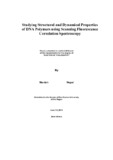Please use this identifier to cite or link to this item:
http://archive.nnl.gov.np:8080/handle/123456789/364| Title: | Studying Structural and Dynamical Properties of DNA Polymers using Scanning Fluorescence Correlation Spectroscopy |
| Authors: | Polymer Physics, Polymer Solution |
| Keywords: | Polymer Physics |
| Issue Date: | 26-Mar-2019 |
| Abstract: | Being the carrier of genetic information, DNA is, perhaps, the most important polymer around. It is also a very interesting polymer from the Physics point of view due to the scale of its persistence length ~50 nm, that is much larger than the diameter of DNA double helix (2 nm) yet is typically much smaller than the DNA contour length (> 1m). This defines DNA as a semi-flexible polymer with structural and dynamic properties distinct from those of flexible chains (a majority of synthetic polymers) and stiff polymers (such biofilaments as microtubules and actin). However, prior to our work there were no good experimental tools to measure DNA structure at the length scales above 50 nm. In this thesis a new approach combining scanning fluorescence correlation spectroscopy (SFCS) and covalent DNA labelling is successfully implemented to study various structural and dynamical properties of DNA solutions. In particular, in dilute DNA solutions we confirm for the first time the theoretical prediction of an essentially ideal structure of DNA chains: because of low DNA flexibility the probability of collision between DNA segments is low for contour lengths up to ~ 60m. And indeed the structure factors 𝑆(𝑞) obtained in our measurements follow the Debye expression for ideal polymers. The scaling of gyration radius 𝑅 with DNA contour length L (𝑅 ∝ 𝐿.±.) is also consistent with the ideal worm-like chain behaviour. With the use of specific labelling, our technique also allows us to assess DNA end-to-end distance distribution. It appears to follow Gaussian distribution in a further confirmation of the ideal nature of DNA coils. In another application of specific labeling, we probe the structure of individual labeled DNA coils embedded in a dense mesh of other unlabeled DNA (semi-dilute solutions). For flexible polymers such conditions lead to shrinking of their coils with increasing concentration. However, our measurements on DNA reveal that their chain structure does not change up to the concentration of 600 , about 30 times larger than the chain overlap concentration. The invariance of the individual chain structure despite the dense organisation of polymer matrix is a remarkable feature of semi-flexible polymers not previously explored experimentally. |
| Description: | Submitted to the Senate of Ben-Gurion University of the Negev |
| URI: | http://103.69.125.248:8080/xmlui/handle/123456789/364 |
| Appears in Collections: | 500 Natural sciences and mathematics |
Files in This Item:
| File | Description | Size | Format | |
|---|---|---|---|---|
| ManishNepalThesesWithTitlePagesFixed.pdf | 2.19 MB | Adobe PDF |  View/Open |
Items in DSpace are protected by copyright, with all rights reserved, unless otherwise indicated.